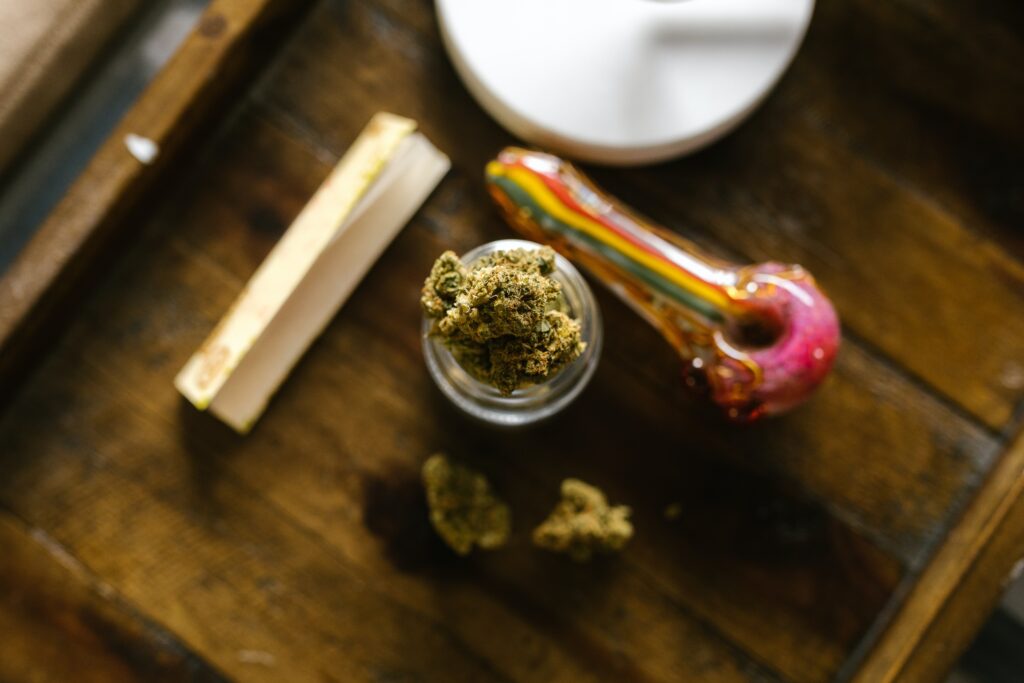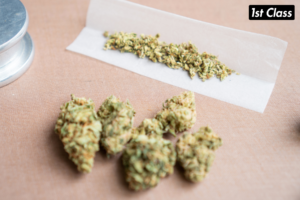Cannabis Knowledge – is key and to have a cohesive team effort, you r cannabis business employees should all have at least a shared minimum basic knowledge of cannabis and cannabis products. When you’re opening a cannabis business in a newly legalized state it is only natural that you’ll have more training to do since the work force in your state won’t yet be highly experienced in the cannabis industry. Here are some basic cannabis product knowledge terms that all of your team should know, owners included. It’s a great place start, and then your team competency will grow from there!

Cannabis Glossary
There is a lot of terminology involved with operating in the cannabis industry. For newcomers, learning all of these terms can often be overwhelming and can initially be quite confusing. Here is some core terminology to know for any cannabis industry worker or owner to keep up in conversation.
Aroma
“Aroma” is a term used to describe the general smell and/or taste of a certain plant or flower. Because consumers’ individual definition of aromas (such as “earthy,”skunky,” or “citrus”) can differ
somewhat, aroma descriptions are meant as a basic guideline.
Backcross (BX)
A backcross is a hybrid plant that has been bred with one of its parents (or a plant that is genetically similar) in order to create offspring that is closer to that of the original parent. For example, a grower could breed a plant with its own father to make sure the baby has its dad’s height. This is often done to maintain rarer strains or strengthen those with desired recessive genes.
BHO
BHO stands for butane hash oil and is a potent concentrate of cannabinoids made by dissolving marijuana in its plant form in a solvent (usually butane). The resulting product has very high THC levels(generally more than flowers or hashish) and is a thick, sticky oil. BHO is also referred to as honey oil,”dabs” or “dabbing,” earwax, or shatter, depending on the manufacturing method.
Bud
Bud refers to the actual flower of the marijuana plant. These are the fluffy parts that are harvested and used for recreational or medicinal purposes as they contain the highest concentrations of active cannabinoids.
Cannabinoids
Cannabinoids are the chemical compounds unique to cannabis that act upon the human body’s cannabinoid receptors, producing various effects including pain relief and other medically beneficial uses. Marijuana’s most well-known cannabinoid is tetrahydrocannabinol (THC) due to the fact that it is the most abundant, and also because it produces the psychoactive effects (or the “high”) that drives the plant’s recreational use. However, there are over 85 known cannabinoids all with varying effects, so THC isn’t the only one.
Cannabis
Cannabis is a plant genus that produces three species of flowering plants: Cannabis sativa, Cannabis indica, and Cannabis ruderalis. Cannabis sativa and Cannabis indica are used to produce both recreational and medical marijuana. Cannabis ruderalis is rarely farmed due to its natural lower THC content and small stature, but there is some cross-breeding thanks to ruderalis‘s unique ability to auto-flower rather than mature based on light, so there is potential for this variety to grow in popularity. Cannabis is native to Asia, but grows almost anywhere and has long been cultivated both for the production of hemp and to be used as a drug.
CBD
CBD is the abbreviation for cannabidiol, one of the at least 85 cannabinoids found in cannabis and the second only toTHC when it comes to average volume. Recently, CBD has gained support for its use as a medical treatment as research has shown it effectively treats pain, inflammation, and anxiety without the psychoactive effects (the”high” or “stoned” feeling) associated with THC. High CBD strains, such as Harlequin, are being bred more actively and appearing more frequently on the market.
Concentrates
Concentrates are a potent consolidation of cannabinoids that are made by dissolving marijuana in its plant form into a solvent. The resulting product has very high THC levels (generally more than flowers or hashish), and can produce varying products that range from thick sticky oils (BHO) to moldable goo (budder/wax) to resinous bits (shatter). Referred to, by a variety of slang terms, the classification of concentrates is often dependent on the manufacturing method and the consistency of the final product.
Co-op
Co-op is short for cooperative and refers to a community of patients or consumers in a given area who join together to share and receive marijuana. Co-ops usually have specific membership requirements and the product available is generally exclusive to members. In some states, co-ops exist alongside or in lieu of dispensaries.
Cross (genetics)
A cross (referring to crossbreeding) is the result when two different plant strains are bred together. For example, BlueDream is a cross between Blueberry and Haze strains.
Dab/Dabbing
A dab is a slang term used to refer to a dose ofBHO received through butane combustion and inhalation. The act of “dabbing”refers to partaking in dabs.
Decarboxylation
Heating cannabis to temperatures of 220 degrees or more turns non psychoactive THCA into psychoactive THC.
Dispensary
Dispensary is a general term used to refer to any location where a patient or consumer can legitimately and safely access cannabis, whether the business is technically an accesspoint, pick-up location. co-op, collective or any other version of a legal cannabis distributor.
Edibles/Medibles
Edibles and “medibles” are medicated edible goods that have been infused with cannabis extracts. They are commonly baked goods such as cookies and brownies, but options as varied as flavored coffee drinks, breads, and candies exist as well. Dispensaries also often sell marijuana-infused butters or oils for patients or consumers to make their own edibles. Consuming edibles means the active components from the extracts require longer to take effect as they need to be absorbed through the digestive system.
Entourage Effect
result of the terpenes and the cannabinoids (like THC and CBD) working together.
Flowers
You probably know what flowers are; they’re often the “pretty” part of a plant, and the same is true for cannabis. While cannabis flowers don’t have traditional petals or look like daisies, they are still the reproductive organ of the female plants.Cannabis flowers are the hairy, sticky, crystal-covered bits that are harvested and dried to be used as medication. When they are allowed to be fertilized by male plants, these flowers will produce cannabis seeds. If not, they will continue to produce the resin that contains their active cannabinoids until they are harvested or begin to die.
Hash/Hash Oil
Hash is short for hashish, which is derived from cannabis plants and can be used for consumption or medication. Production involves the removal of the plant’s trichomes by sieving or filtering. Once
the cannabinoid-laden powder has been collected, it is typically pressed and ready to be used. Hash ranges in potency, but is generally stronger than straight flowers since everything but the active part of the plant has been removed. A similar concentrated product can also be produced chemically using a solvent; however, this product is commonly referred to as hash oil or “honey oil.”
Heirloom
An heirloom refers to a cannabis strain that was taken from its native homeland and propagated in another geographical location.
Hemp
Hemp is a fibrous product that can be produced from the male cannabis plant and can be used in the manufacture of rope, paper, beauty products, and a vast array of other products. Hemp plants have no value as a drug since they are males. However, they are still considered illegal in the United States.
Hybrid
Hybrid refers to a plant that is genetically a cross between one or more separate strains of cannabis. Hybrids can happen unintentionally, but they are usually bred specifically to combine desired traits of the original plants. Most marijuana on the market today is some form of hybrid.
Hydroponics
Hydroponics refers to a system of gardening that does not use soil. Plants are grown in water and receive their nutrients from the addition of solutions rather than soil. For growers, hydroponic advantages include more control over nutrient intake and stability. In terms of marijuana production, plants grown hydroponically are sometimes said to have cleaner, more distinct flavors.
Indica
Indica is the less scientific name for the Cannabis indica species of cannabis. Generally these plants originated in the Middle East and Asia and include both of the famous kush and Afghan lineages. Compared to their sativa counter parts, the plants are shorter, bushier and have more compact flower structure. This species tends to produce more relaxing physical effects and can have a sedative quality.
Kief
Kief is a collected amount of trichomes that have been separated from the rest of the marijuana flower. Since trichomes are the sticky crystals that contain the vast majority of the plant’s cannabinoids, kief is known to be extremely potent. Kief is sometimes mistakenly referred to as pollen and is the primary ingredient in hashish production.
Landrace
A landrace refers to a local variety of cannabis that has adapted to the environment of its geographic location. This accounts for genetic variation between landrace strains, which have been crossbred to produce the cannabis variety we see today. Landrace strains are oftentimes named after their native region, like Afghani, Thai, and Hawaiian, and traces of landraces are sometimes detectable in the names of their crossbred descendants.
Marijuana
Marijuana is the general term for female cannabis plants or their dried flowers. Females are distinct from male plants in that they are the ones that produce flowers which contain the high percentage of cannabinoids that hold both their medicinal and psychoactive properties.
OG
OG is a term that’s now used to describe many strains, though the term originated to describe SouthernCalifornia’s Ocean Grown Kush, which was quickly shortened to OG Kush. OG Kush grew quickly in fame and reputation. Most OGs are different variations of the original OG Kush genetics or are also ocean grown on the West Coast.
Phenotype
Phenotype is a term that is heard most often in growing. It refers to the general physical characteristics of the plant such as height, color, branching, leaf configuration down to cell structure—any markers that can be used to identify and judge the healthiness of a plant.
Pistil
Pistils are part of a female plant’s anatomy. On cannabis, it’s identified as the little hair-like extensions on the flowers that range in color from white to red to darker orange-brown. When plants are going to be fertilized, the pistil acts to collect the male pollen. When plants are left unfertilized, as in the case of marijuana, the pistils change and can be indicators of plant ripeness.
Ruderalis
Ruderalis is a low-THC cannabis variety that is primarily selected by breeders for its CBD-rich genetics. Unlike Cannabis sativa and indica, which use light cycles to flower, ruderalis is an”auto flowering” variety, meaning it flowers with age. Originating inRussia, ruderalis is a hardy plant that survives harsh climates.
Sativa
Sativa is the less scientific name for the cannabis sativa species of cannabis plant. In general, these plants originated outside of the Middle East and Asia and include strains that are from areas such as South America, the Caribbean, Africa, and Thailand. These strains tend to grow taller as plants (usually over 5 feet), are lighter in color and take longer to flower. When consumed, sativas tend to produce more cerebral effects as opposed to physical and sedative ones.
Shatter/Ice
Shatter or ice are terms used to refer to BHO.
Strain
A strain is a specific variety of a plant species. Strains are developed to produce distinct desired traits in the plant and are usually named by their breeders (or by creative consumers). Strain names often reflect the plant’s appearance, its promised buzz, or its place of origin. Although the medical marijuana industry strives for consistency, strains can easily be mistakenly or purposely misidentified.
Terpene
Terpenes create the aroma of cannabis.Flower strains smell different because they contain different terpenes(referred to as a “terpene profile”).
THC
THC is an abbreviation for tetrahydrocannabinol. It is the most well-known and most abundantly
available cannabinoid in marijuana plants. THC is also the component in marijuana that is responsible for the psychoactive effects, or the “high.” Also known as delta-9-tetracannabinol, it was first isolated in 1964 and is thought to serve as a natural defense for the plant against pests. Research has shown THC to bean effective medical treatment for a range of conditions. There is no lethal dose of the compound in its natural form.
Tincture
A tincture is a liquid cannabis extract usually made with alcohol or glycerol that is often dosed with a dropper.Tinctures can be flavored and are usually placed under the tongue, where they are absorbed quickly. Effects can be felt within minutes. Tinctures can also be mixed into a drink, but in these cases effects will take longer because the tinctures will be absorbed by the digestive system.
Topical
A topical is a type of cannabis product where the active properties of the flowers have been extracted and added to a product such as a lotion or a cream that’s applied to the skin. The medicinal properties are absorbed through the skin and can be used to treat muscle aches, long term soreness, or ailments like dry skin.
Trichome
Trichomes are the resin production glands of the cannabis plant. In Greek the word means “growth of hair,” and while these sticky little protrusions can make plants appear a little hairy, they are not hairs, nor are they “crystals,” which is how they are often described. THC, CBD and other cannabinoids are all produced in these glands.
Vaporizer
A vaporizer is a device used to consume marijuana. It heats either flowers or marijuana-infused oils to a temperature that produces a cannabinoid-laced vapor to inhale. Vaporizing is healthier than smoking since there is no smoke to ingest, but this method still produces near instant effects. With new, more compact models on the market, vaporizing is growing in popularity.
Wax
Wax is another form of concentrate. Can be created through BHO, CO2, PHO, or Ice Water extraction methods.
Cannabinoids
Cannabinoids are chemical compounds that are unique to cannabis. They impact the healing properties of the plant and the user experience. Most people have heard of THC and CBD but don’t know that there are so many more cannabinoids working in cannabis and cannabis products. We’d have to write a book to go in to all of the cannabinoids that have been discovered thus far, so here we’ll cover some of the most well-known and prevalent.
*CBD
Fullname: Cannabidiol
Benefits: anti-convulsive, anti-anxiety, anti-psychotic, anti-nausea, anti-rheumatoid arthritic, blood sugar regulation and sedative properties.
Factoids: Counteracts THC
Psychological impact: Non-intoxicating
What it may treat: acne, ADD, anxiety, arthritis, cancer, chronic pain, depression, diabetes, Dravet syndrome, epilepsy, glaucoma, Huntington’sDisease, inflammation, mood disorders, multiple sclerosis, neuropathic pain,Parkinson’s, schizophrenia, and neurodegenerative diseases such as Alzheimer’s.
CBD has also been shown to stop the spread of cancer cells.
CBG
Fullname: Cannabigerol
Benefits: Gastrointestinal issues, interocular pressure
Factoids: Mostly found in hemp. When found in flower it is usually less than 1% Psychoactive: NO
What it may treat: Glaucoma, intestinal issues such as irritable bowels yndrome
CBN
Fullname: Cannabinol
Benefits: anti-bacterial, sleep aide, pain relief, anti inflammatory, anti-convulsive
Factoids: it is a product of THC degradation
Psychoactive: WEAK
What it may treat: Insomnia,MRSA
*THC
Fullname: TetraHydroCannabinol
Benefits: relaxation, reduced pain, and increased appetite.
Psychoactive: YES
What it may treat: ALS (Lou Gehrig’s disease), Alzheimer’s, anxiety, arthritis, chemotherapy side effects, Crohn’s Disease, chronic pain, fibromyalgia, HIV-related peripheral neuropathy, Huntington’s Disease, incontinence, insomnia, multiple sclerosis, pruritus, sleep apnea, and TouretteSyndrome, among others. THC has even been shown to reduce cancerous tumors!
THCA
Fullname: TetraHydroCannabinolic acid
Benefits: anti-inflammatory, antiemetic, anti-prostate cancer, anti-vomiting and neuro-protective Factoids: Turns into psychoactive THC (through decarboxylation) when heated to 240 degrees Psychoactive:NO (because it is not decarboxylated)
What it may treat: chronic immune system disorders, arthritis, endometriosis, menstrual cramps.
THCV
Full name: TetraHydroCannabivarin
Benefits: appetite suppression, reduced blood sugar and bone growth stimulation Factoids: It intensifies the euphoric high of THC, energizing,
Psychoactive: YES
What it may treat: Diabetes, panic attacks, alzheimers, stimulates bonegrowth
Terpenes
Terpenes (Commonly referred to as“Terps”) are responsible for the aromas, flavors, and even colors associated with various plants, including cannabis. Terpenes are what make certain strains smell or taste different from others.
Basics of Terpenes
- Effect the smell of cannabis
- Effect the flavor of cannabis
- Influence the effect of cannabis
- 140 Terpenes found in cannabis
- Each strain has a different “terpene profile” – combination of terpenes contained in the flower
Effect on Receptors & Neurotransmitters
Terpenes act as serotonin uptake inhibitors (similar to anti-depressants like Prozac)
enhance norepinephrine activity (similar to tricyclic antidepressants like Elavil) increase dopamine activity
augment GABA (the “downer” neurotransmitter that counters glutamate, the“upper”)
Note:
Because terpenes influence the effects of cannabis, knowing the main terpenes will greatly increase your ability to successfully guide people toward the effect that they are looking for, beyond focusing simply on THC percentage.
The effect of any given strain is the result of the terpenes and the cannabinoids (like THC and CBD) working together. This is called the “entourage effect.”
Learn more at : Leafly
Common Terpenes
Some terpenes have been found to have medicinal benefits. That means, there are non-psychoactive compounds that can be used to safely treat an array of medical conditions. There are a ton of different terpenes in cannabis, but here are 11profiles you should know about.
- Limonene
- Myrcene
- Linalool
- Alpha Bisobolol
- Delta 3 Carene
- Borneol
- Alpha-Pinene / Beta-Pinene
- Eucalyptol
- Terpineol
- Caryophyllene
- Cineole
Limonene
Flavor / Aroma: Citrus.
Medicinal Uses: promote weight loss, prevent and treat cancer, and treat bronchitis. It can also be used to
Myrcene
Flavor / Aroma: Earthy and musky with a hint of fruity flavors.
Medicinal Uses: Myrcene has been shown to be an effective anti-inflammatory. It also works as a sedative and muscle relaxer.This could possible contribute to the tired/stoney feeling often attributed to indicas.
Linalool
Flavor / Aroma: Floral with a hint of spice.
Medicinal Uses: Can be used as an anti inflammatory. It also helps to modulate motor movements. Another
Note: In addition to cannabis, linalool can be found in an array of flowers, mint, cinnamon, and even some fungi.
Alpha Bisabolol
Flavor / Aroma: Floral.
Medicinal Uses: Can be used to heal wounds, fights bacteria, and can be used a deodorizer. Research suggests alpha bisabolol has been effective in treating a variety of inflammations. Note: also found in chamomile.
Delta 3 Carene
Flavor / Aroma: Piney / earthy.
Medicinal Uses: Anti inflammatory. It is also known to dry fluids like tears, running noses, and menstrual flows.
Borneol
Flavor / Aroma: Earthy and camphor.
Medicinal Uses: analgesic, anti-insomnia, anti-septic, and bronchodilator.
Alpha-Pinene / Beta-Pinene
Flavor / Aroma: Pine.
Medicinal Uses: Pinene has been shown to have anti inflammatory properties.
Note: This is partially where pine trees get their scent from. study found that. Linalool could be used to help treat liver cancer.
Eucalyptol
Flavor / Aroma: Spicy.
Medicinal Uses: Eucalyptol is used in a variety of products including cough suppressants, mouthwash, and body powder.
Note: Eucalyptol is used as a cooking spice and fragrance.
Terpineol
Flavor / Aroma: Pine, clove.
Medicinal Uses: Studies suggest cannabis-extracted terpineol contains antioxidant properties.
Caryophyllene
Flavor / Aroma: Hoppy. (Cannabis and hops used to make beer are basically cousins).
Medicinal Uses: Studies suggest that caryophyllene may help treat anxiety and depression.
Cineole
Flavor / Aroma: Herbal.
Medicinal Uses: Anti-inflammatory, antibiotic, antiviral, anti-nociceptive.
Common Products
There is an array of cannabis product types and new products are developed regularly. Some tried and true products which are well known and well-liked by consumers include:
Flower: dried cannabis flower
Edibles: cannabis oil infused foods and candies
Beverages: cannabis infused coffees, teas, seltzers and waters
Tinctures: extract in liquid form
Topicals: lotions, patches, balms, lube, massage oils, etc.
Pills/capsules: pills filled with extracted oil with a specific THC or CBD dosage
Concentrates: oil, wax, resin, shatter, badder, etc.
Suppositories: Tampons, anal suppositories
Tips:
- Start with a low mg dose
- Tolerance differs, so just because a friend can handle a certain serving amount doesn’t mean you will be able to.
- Edibles are not created equally – Base consumption amount on mg concentration, not product type. 1⁄4 of a brownie with 100mg is much different than 1⁄4 of a brownie with 400 mg. Make sure to pay attention to the listed total mg content and the listed serving size.
- Effects can take between 30 minutes and 2 hours to set in.
- Don’t eat too much (You’ll be super high. Possibly in a really unpleasant way.)
- Read the package for serving size information. Often one edible is actually meant to be consumed in multiple servings.
- Effects are more intense on an empty stomach. Eat first when beginning. If you eat afterwards, the food won’t soak up the THC, it may actually intensify the high.
source : leafsheets.com




